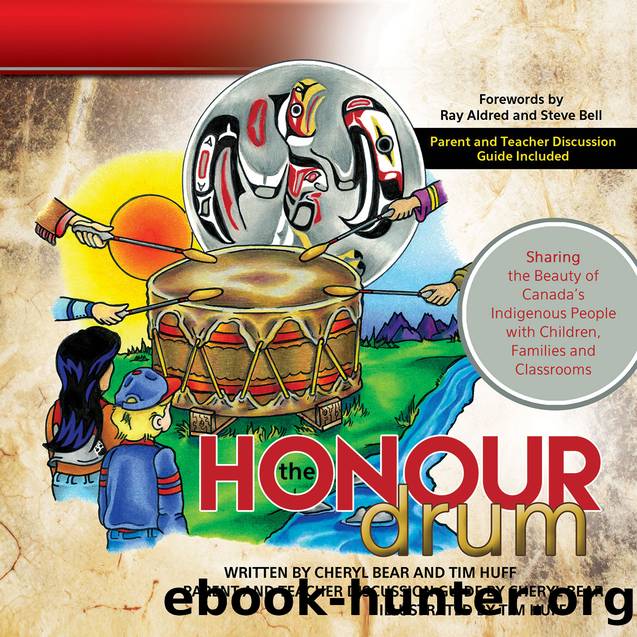The Honour Drum by Tim J Huff

Author:Tim J Huff
Language: eng
Format: epub
Tags: Indigenous, children, lessons, family, classrooms
Publisher: Castle Quay Books
Published: 2016-12-29T00:00:00+00:00
Totem poles too
have a story to tell
Of nations and chiefs
and families that dwell.
It is often assumed that all Indigenous people in Canada and the USA have totem poles and liveâor livedâin tipis. But this is a stereotype. In this picture, we see a totem pole. A totem pole is a large sculpture carved on a pole or large tree, yellow or red cedar, by Indigenous peoples of the Pacific Northwest. It is one of the most recognizable cultural symbols of the Pacific Northwest, and even other countries of the world know about totem poles. This particular totem pole is based on one from Stanley Park in Vancouver, BC. (The background photo also represents the well-known totem poles in Stanley Park.) Authentic totem poles are found only on the west coast, in Washington State, British Columbia and Alaska.
While totem poles are sometimes found elsewhere, even with the best of intentions the use of an inauthentic totem pole is disrespectful to west coast Indigenous people. Any replications should be used with permission and used to honour a people, not misrepresent them further.
The images on the totem are usually of beings, or animals, which represent different clans, and every clan is a family group. The figures on the totem pole mark a familyâs lineage. I (Cheryl Bear) am of the Bear Clan, so when I see a bear on a totem pole, it makes me feel proud and connected.
The tree used for the totem is chosen carefully for its beauty, character and uniqueness. Before the tree is cut down, it is honoured and shown great respect.
Some people assume that totem poles are religious symbols, but they are not. Totem poles are a way of recording the story of a chief or family and sometimes even point the way to a good fishing spot.
Ancient cultures used oral tradition to tell their story. By story, we donât mean legend, myth or fable; we mean our history, the story of our people. The totem pole is a means of communicating our history. It is a way of telling the histories or ancestry of a family, a clan or a community. This means the stories were passed down through generations through the telling of the story, with song, stone, oratory or carving, rather than by writing it down.
Some non-Indigenous people may find totems and Indigenous artwork alarming, but it is just a different style of art that may be unfamiliar. I (Cheryl Bear) have often found abstract art to be daunting, or even scary, but once I took the time to understand what it represented, I gained a different appreciation for it.
Discussion Questions
1. What are some of the clans you see represented on the totem pole in the picture?
2. Have you ever seen a totem pole? If so, where?
3. Does your family have any kind of symbol (for example, crest, tartan)?
Download
This site does not store any files on its server. We only index and link to content provided by other sites. Please contact the content providers to delete copyright contents if any and email us, we'll remove relevant links or contents immediately.
Alas salvajes (Wings in the Wild) by Margarita Engle(133)
Anne Frank in the Secret Annex by The Anne Frank House(118)
Golda Meir by Meron Medzini(108)
They Made a Revolution by Jules Archer(104)
my name was mushroom by Wendy L Baker(74)
Reflections: On the Magic of Writing: On the Magic of Writing by Jones Diana Wynne(68)
Breaking Down Vonnegut by Julia A. Whitehead(67)
insanely great by Unknown(54)
We Will Always Be Here by Jenny Kalvaitis(53)
The General's Little Angel by Breanna Hayse(52)
The Broken Miracle_Part One_The Broken Miracle Duology by J D Netto(41)
Niels Bohr: atomic theorist by Ray Spangenburg Diane Kit Moser(38)
The Honour Drum by Tim J Huff(34)
Alien Minds by Christina Bauer(32)
Women in Medicine by Karen Horney(24)
New Gillion Street by Elliot Harper(23)
#BlackInSchool by Habiba Cooper Diallo(21)
Jerry Rice by Sterngass Jon(19)
Modern Peacemakers by Mairead Corrigan & Betty Williams(18)
